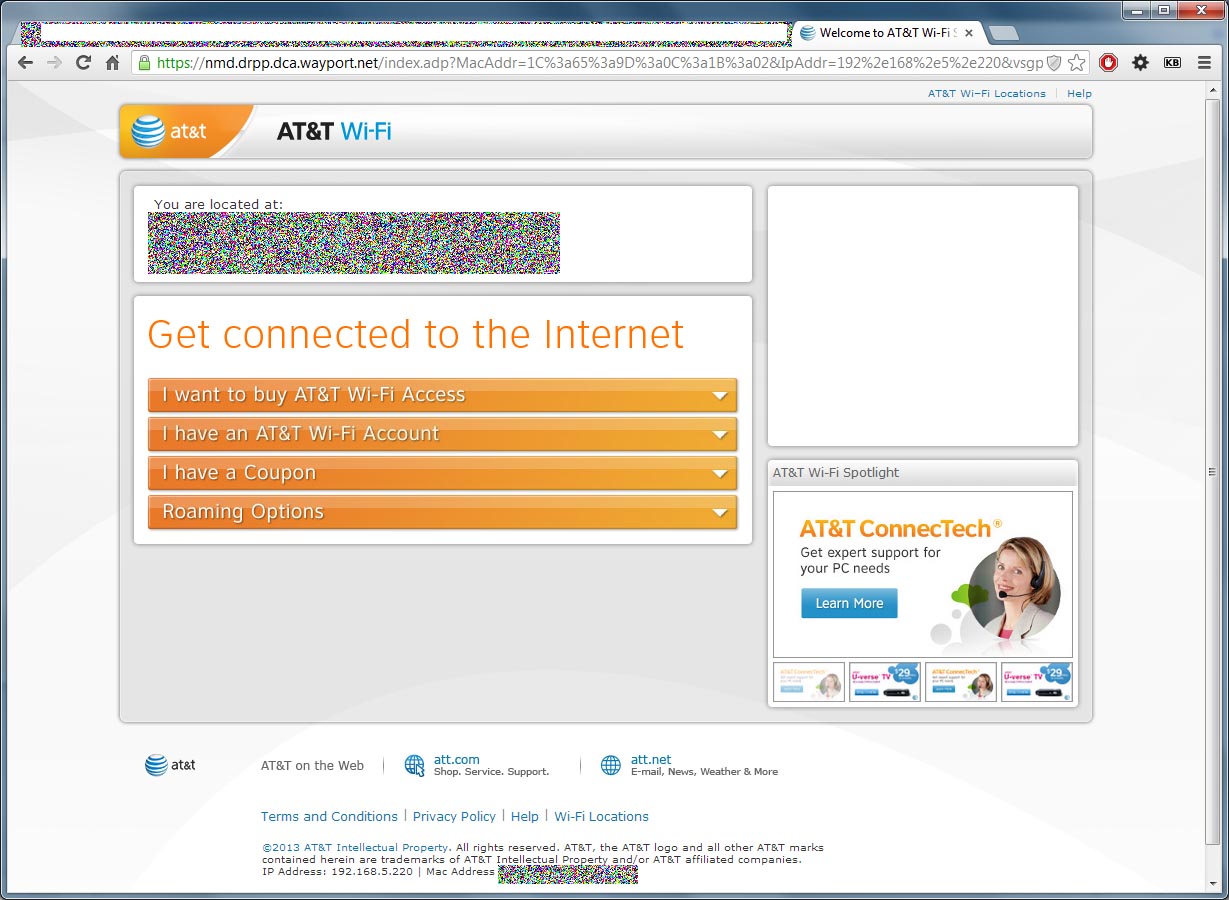Came across a resort with this lame login page prompting the user to purchase access.

Ended up purchasing access. Hell, I don’t have my iodine server setup or anything. Will have to remember to do that before going out to resorts with lame $30 charges for 7 days of horrible net.
After purchasing access, the AT&T server basically records your MAC address and allows it for access for the next X amount of time you purchased it.
The obvious solution is to use a program like Virtual Router and create a local hotspot with the machine that was purchased access as host. But for some odd reason, mine didn’t work!
Ok, fine. At this point, I figure I had these options:
Fix Virtual Router
Try to change MAC address
Work with a friend and setup an iodine server
Buy access on the other machine
Since Virtual Router didn’t work for some reason, and it worked last time, I recalled that the only thing that most likely had an impact on it was AVG.
Uninstalled AVG security. That thing was prompting the user to purchase the product via heavy heavy product marketing. Like, yes, thank you I know I am using a free version, please stop stealing my screen focus with your huge popup! It also steals control of the firewall functionality in Windows 7, which we will discuss later on what the impact of it is.
I figure #2 was nearly as easy to do.
I figured I could just change the MAC address of the other machines and session steal the paid MAC address. But it seems there’s limitations on changing the MAC on wifi cards. The prefix to the MACs must start with 00 or 02. And my MAC address of the machine I used to purchase the internet access (let’s call it Silver1) had a MAC that didn’t start with 00 nor 02. Great. My machine I was trying to get access to Silver1 on (let’s call it Black1) didn’t support MAC changes out of the limitation. Funny enough, it allowed a change to DE:AD:BE:EF:xx:xx, where x denotes any alphanumeric character. Nice, but this doesn’t help. (I was using ifconfig, and also tried macchanger.)
So I figure maybe Windows 7 is limiting me on this. I thought I’d do it on Linux. But I would need an actual installation (so the virtual machine I usually use to code was ruled out). It just happened that my installation of Ubuntu still existed on the hard drive, but its boot loader was overwritten by Windows 7. I had reinstalled Windows 7 because it had hardware driver issues that was beyond fix without a system reinstall.
So for the reinstall, I basically got out my Ubuntu Live USB and reinstalled GRUB 2. There. Now I can dual boot Ubuntu and Windows 7 again.
I get into Ubuntu to try and change the MAC address there, but it also had limitation on that the hardware doesn’t support Silver1’s MAC because it was out of bounds.
Great, now I get back to trying to fix Virtual Router. It seems that after uninstalling AVG, AVG didn’t leave without first recking havoc through my registry. I used to have Windows 7 firewall, and Internet Connection Sharing (ICS) services running, but now both are disabled and no permissions granted in the registry.
Error like this occurs when starting:
When you attempt to start the Windows 7 firewall service you receive the following error
Windows could not start the Windows Firewall on Local Computer. For more information, review the system event log. If this is a non-Microsoft service, contact the service vendor, and refer to service-specific error code 5.
If you look in the System Event Log, you will see event 7024 from the Service Control Manager
The Windows Firewall service terminated with service-specific error Access is denied..
This may be caused because the “NT Service\MpsSvc” account does not have adequate permissions on the following registry key
HKLM\SYSTEM\CurrentControlSet\Services\SharedAccess
This can be fixed by:
In Registry Editor, browse to the key HKLM\SYSTEM\CurrentControlSet\Services\SharedAccess
Right click SharedAccess, and click Permissions.
Click Add.
In the “Enter the object names to select” field, type “NT SERVICE\mpssvc”. Then click CheckNames. The name should change to MpsSvc
Click OK.
Select Full Control in the Allow column.
Click OK.
Enable the ICS and firewall service in services.msc
Reboot
Now starting the Virtual Router should be okay. At least, it worked for me.
The end result looks like this